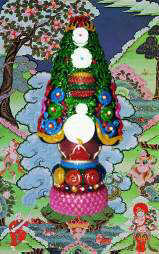| Art Q&A > Crafts |
|
|
Butter Sculptures
In 641, when Princess Wencheng of the Tang Dynasty was married to the then Tibetan king Songtsan Gambo, she brought along a sculpture of Sakyamuni, which was later enshrined and worshipped at the Jokhang Temple. To show their respect, the Tibetan people presented offerings in front of the Buddha. According to the traditional customs observed in India, offerings to Buddha and Bodhisattvas were divided into six categories: the flower, Tu incense, divine water, Wa incense, fruit, and the Buddha light. By that time, however, all of the flowers and trees had died, so the Tibetan people made a bunch of flowers from butter instead.
In the beginning, butter sculptures were simple and the techniques were rough. Later, two institutions were set up in the Taer Monastery to train monk artists specializing in this art. With a passion for Buddha and the arts, the monks worked hard and learned from each other to overcome their own weaknesses, thus enriching the art in terms of pattern and content.
The making of butter sculptures is rather unique and complex: Since butter melts easily it is modeled by hand in cold conditions (usually on winter days) by monk artists.
|
|||||
All rights reserved. Reproduction of text for non-commercial purposes is permitted provided that both the source and author are acknowledged and a notifying email is sent to us. |
|||||
 |

 Origin
of Butter Sculptures
Origin
of Butter Sculptures

 The
Making of Butter Sculptures
The
Making of Butter Sculptures